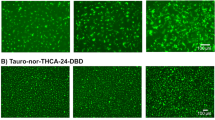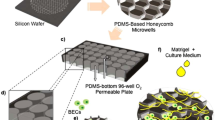Abstract
Primary human hepatocytes (PHH) are still considered as gold standard for investigation of in vitro metabolism and hepatotoxicity in pharmaceutical research. It has been shown that the three-dimensional (3D) cultivation of PHH in a sandwich configuration between two layers of extracellular matrix (ECM) enables the hepatocytes to adhere three dimensionally leading to formation of in vivo like cell–cell contacts and cell–matrix interactions. The aim of the present study was to investigate the influence of different ECM compositions on morphology, cellular arrangement and bile canaliculi formation as well as bile excretion processes in PHH sandwich cultures systematically. Freshly isolated PHH were cultured for 6 days between two ECM layers made of collagen and/or Matrigel in four different combinations. The cultures were investigated by phase contrast microscopy and immunofluorescence analysis with respect to cell–cell connections, repolarization as well as bile canaliculi formation. The influence of the ECM composition on cell activity and viability was measured using the XTT assay and a fluorescent dead or alive assay. Finally, the bile canalicular transport was analyzed by live cell imaging to monitor the secretion and accumulation of the fluorescent substance CDF in bile canaliculi. Using collagen and Matrigel in different compositions in sandwich cultures of hepatocytes, we observed differences in morphology, cellular arrangement and cell activity of PHH in dependence of the ECM composition. Sandwich-cultured hepatocytes with an underlay of collagen seem to represent the best in vivo tissue architecture in terms of formation of trabecular cell arrangement. Cultures overlaid with collagen were characterized by the formation of abundant bile canaliculi, while the bile canaliculi network in hepatocytes cultured on a layer of Matrigel and overlaid with collagen showed the most branched and stable canalicular network. All cultures showed a time-dependent leakage of CDF from the bile canaliculi into the culture supernatant with variations in dependence on the used matrix combination. In conclusion, the results of this study show that the choice of ECM has an impact on the morphology, cell assembly and bile canaliculi formation in PHH sandwich cultures. The morphology and the multicellular arrangement were essentially influenced by the underlaying matrix, while bile excretion and leakage of sandwich-cultured hepatocytes were mainly influenced by the overlay matrix. Leaking and damaged bile canaliculi could be a limitation of the investigated sandwich culture models in long-term excretion studies.







Similar content being viewed by others
References
Abe K, Bridges AS, Brouwer KL (2009) Use of sandwich-cultured human hepatocytes to predict biliary clearance of angiotensin II receptor blockers and HMG-CoA reductase inhibitors. Drug Metab Dispos Biol Fate Chem 37(3):447–452. doi:10.1124/dmd.108.023465
Berthiaume F, Moghe PV, Toner M, Yarmush ML (1996) Effect of extracellular matrix topology on cell structure, function, and physiological responsiveness: hepatocytes cultured in a sandwich configuration. FASEB J 10(13):1471–1484
Bi YA, Kazolias D, Duignan DB (2006) Use of cryopreserved human hepatocytes in sandwich culture to measure hepatobiliary transport. Drug Metab Dispos Biol Fate Chem 34(9):1658–1665. doi:10.1124/dmd.105.009118
Bi YA, Kimoto E, Sevidal S et al (2012) In vitro evaluation of hepatic transporter-mediated clinical drug-drug interactions: hepatocyte model optimization and retrospective investigation. Drug Metab Dispos Biol Fate Chem 40(6):1085–1092. doi:10.1124/dmd.111.043489
Boyer JL (1997) Isolated hepatocyte couplets and bile duct units–novel preparations for the in vitro study of bile secretory function. Cell Biol Toxicol 13(4–5):289–300
Brouwer K, Tian X, Zhang P, Hoffmaster K (2010) Pulsing of bile compartments in sandwich-cultured hepatocytes. Google Patents
De Bruyn T, Chatterjee S, Fattah S et al (2013) Sandwich-cultured hepatocytes: utility for in vitro exploration of hepatobiliary drug disposition and drug-induced hepatotoxicity. Expert Opin Drug Metab Toxicol 9(5):589–616. doi:10.1517/17425255.2013.773973
Dunn JC, Tompkins RG, Yarmush ML (1991) Long-term in vitro function of adult hepatocytes in a collagen sandwich configuration. Biotechnol Prog 7(3):237–245. doi:10.1021/bp00009a007
Elaut G, Henkens T, Papeleu P et al (2006) Molecular mechanisms underlying the dedifferentiation process of isolated hepatocytes and their cultures. Curr Drug Metab 7(6):629–660
Gillette KM, Forbes K, Sehgal I (2003) Detection of matrix metalloproteinases (MMP), tissue inhibitor of metalloproteinase-2, urokinase and plasminogen activator inhibitor-1 within matrigel and growth factor-reduced matrigel basement membrane. Tumori 89(4):421–425
Godoy P, Hewitt NJ, Albrecht U et al (2013) Recent advances in 2D and 3D in vitro systems using primary hepatocytes, alternative hepatocyte sources and non-parenchymal liver cells and their use in investigating mechanisms of hepatotoxicity, cell signaling and ADME. Arch Toxicol 87(8):1315–1530. doi:10.1007/s00204-013-1078-5
Grinberg M, Stober RM, Edlund K et al (2014) Toxicogenomics directory of chemically exposed human hepatocytes. Arch Toxicol 88(12):2261–2287. doi:10.1007/s00204-014-1400-x
Gross-Steinmeyer K, Stapleton PL, Tracy JH et al (2005) Influence of Matrigel-overlay on constitutive and inducible expression of nine genes encoding drug-metabolizing enzymes in primary human hepatocytes. Xenobiotica 35(5):419–438. doi:10.1080/00498250500137427
Hamilton GA, Jolley SL, Gilbert D, Coon DJ, Barros S, LeCluyse EL (2001) Regulation of cell morphology and cytochrome P450 expression in human hepatocytes by extracellular matrix and cell-cell interactions. Cell Tissue Res 306(1):85–99
Hoffmann SA, Muller-Vieira U, Biemel K et al (2012) Analysis of drug metabolism activities in a miniaturized liver cell bioreactor for use in pharmacological studies. Biotechnol Bioeng 109(12):3172–3181. doi:10.1002/bit.24573
Hoffmaster KA, Zamek-Gliszczynski MJ, Pollack GM, Brouwer KL (2005) Multiple transport systems mediate the hepatic uptake and biliary excretion of the metabolically stable opioid peptide [D-penicillamine2,5]enkephalin. Drug Metab Dispos Biol Fate Chem 33(2):287–293. doi:10.1124/dmd.104.001420
Knobeloch D, Ehnert S, Schyschka L et al (2012) Human hepatocytes: isolation, culture, and quality procedures. Methods Mol Biol 806:99–120. doi:10.1007/978-1-61779-367-7_8
Kojima T, Yamamoto T, Murata M, Chiba H, Kokai Y, Sawada N (2003) Regulation of the blood-biliary barrier: interaction between gap and tight junctions in hepatocytes. Med Electron Microsc 36(3):157–164. doi:10.1007/s00795-003-0220-5
LeCluyse EL (2001) Human hepatocyte culture systems for the in vitro evaluation of cytochrome P450 expression and regulation. Eur J Pharm Sci 13(4):343–368
Liu X, LeCluyse EL, Brouwer KR, Lightfoot RM, Lee JI, Brouwer KL (1999) Use of Ca2+ modulation to evaluate biliary excretion in sandwich-cultured rat hepatocytes. J Pharmacol Exp Ther 289(3):1592–1599
Manninen A (2015) Epithelial polarity–generating and integrating signals from the ECM with integrins. Exp Cell Res 334(2):337–349. doi:10.1016/j.yexcr.2015.01.003
Martinez-Hernandez A, Amenta PS (1993a) The hepatic extracellular matrix. I. Components and distribution in normal liver. Virchows Arch A Pathol Anat Histopathol 423(1):1–11
Martinez-Hernandez A, Amenta PS (1993b) The hepatic extracellular matrix. II. Ontogenesis, regeneration and cirrhosis. Virchows Arch A Pathol Anat Histopathol 423(2):77–84
Moghe PV, Berthiaume F, Ezzell RM, Toner M, Tompkins RG, Yarmush ML (1996) Culture matrix configuration and composition in the maintenance of hepatocyte polarity and function. Biomaterials 17(3):373–385
Musch A (2014) The unique polarity phenotype of hepatocytes. Exp Cell Res 328(2):276–283. doi:10.1016/j.yexcr.2014.06.006
Ng S, Han R, Chang S et al (2006) Improved hepatocyte excretory function by immediate presentation of polarity cues. Tissue Eng 12(8):2181–2191. doi:10.1089/ten.2006.12.2181
Page JL, Johnson MC, Olsavsky KM, Strom SC, Zarbl H, Omiecinski CJ (2007) Gene expression profiling of extracellular matrix as an effector of human hepatocyte phenotype in primary cell culture. Toxicol Sci 97(2):384–397. doi:10.1093/toxsci/kfm034
Pfeiffer E, Kegel V, Zeilinger K et al (2014) Isolation, characterization, and cultivation of human hepatocytes and non-parenchymal liver cells. Exp Biol Med. doi:10.1177/1535370214558025
Rajan N, Habermehl J, Cote MF, Doillon CJ, Mantovani D (2006) Preparation of ready-to-use, storable and reconstituted type I collagen from rat tail tendon for tissue engineering applications. Nat Protoc 1(6):2753–2758. doi:10.1038/nprot.2006.430
Reif R, Karlsson J, Gunther G et al (2015) Bile canalicular dynamics in hepatocyte sandwich cultures. Arch Toxicol 89(10):1861–1870. doi:10.1007/s00204-015-1575-9
Schyschka L, Sanchez JJ, Wang Z et al (2013) Hepatic 3D cultures but not 2D cultures preserve specific transporter activity for acetaminophen-induced hepatotoxicity. Arch Toxicol 87(8):1581–1593. doi:10.1007/s00204-013-1080-y
Swift B, Brouwer KL (2010) Influence of seeding density and extracellular matrix on bile Acid transport and mrp4 expression in sandwich-cultured mouse hepatocytes. Mol Pharm 7(2):491–500. doi:10.1021/mp900227a
Swift B, Pfeifer ND, Brouwer KL (2010) Sandwich-cultured hepatocytes: an in vitro model to evaluate hepatobiliary transporter-based drug interactions and hepatotoxicity. Drug Metab Rev 42(3):446–471. doi:10.3109/03602530903491881
Treyer A, Musch A (2013) Hepatocyte polarity. Compr Physiol 3(1):243–287. doi:10.1002/cphy.c120009
Turncliff RZ, Tian X, Brouwer KL (2006) Effect of culture conditions on the expression and function of Bsep, Mrp2, and Mdr1a/b in sandwich-cultured rat hepatocytes. Biochem Pharmacol 71(10):1520–1529. doi:10.1016/j.bcp.2006.02.004
Vukicevic S, Kleinman HK, Luyten FP, Roberts AB, Roche NS, Reddi AH (1992) Identification of multiple active growth factors in basement membrane Matrigel suggests caution in interpretation of cellular activity related to extracellular matrix components. Exp Cell Res 202(1):1–8
Acknowledgments
We would like to thank Melanie Kießig for her excellent technical assistance. This study was supported by the German Federal Ministry of Education and Research (BMBF) Project Virtual Liver: 0315741 and 0315739.
Author information
Authors and Affiliations
Corresponding author
Electronic supplementary material
Below is the link to the electronic supplementary material.
Supplemental Fig. 1
Biliary excretion. Bile canaliculi from three different donors (A–C) cultured in four different combinations of collagen and Matrigel were treated with CDF-DA over 10 min, and CDF excretion was measured in the supernatant of the cultures over 48 min. Data show means of duplicates (n = 2) (TIFF 454 kb)
Supplemental Table 1
Statistic evaluation of bile canaliculi formation. Filled bile canaliculi in sandwich-cultured hepatocytes after treatment with CDF-DA were quantified (Fig. 5) and statistically analyzed. Data show mean ± SD, p value and levels of significance of three independent experiments (N = 3; n = 3). (XLSX 42 kb)
Rights and permissions
About this article
Cite this article
Deharde, D., Schneider, C., Hiller, T. et al. Bile canaliculi formation and biliary transport in 3D sandwich-cultured hepatocytes in dependence of the extracellular matrix composition. Arch Toxicol 90, 2497–2511 (2016). https://doi.org/10.1007/s00204-016-1758-z
Received:
Accepted:
Published:
Issue Date:
DOI: https://doi.org/10.1007/s00204-016-1758-z




